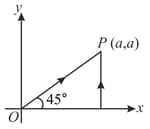Embibe Experts Solutions for Exercise 1: Exercise 5.8
Embibe Experts Physics Solutions for Exercise - Embibe Experts Solutions for Exercise 1: Exercise 5.8
Attempt the practice questions from Exercise 1: Exercise 5.8 with hints and solutions to strengthen your understanding. Gamma Question Bank for Engineering Physics solutions are prepared by Experienced Embibe Experts.
Questions from Embibe Experts Solutions for Exercise 1: Exercise 5.8 with Hints & Solutions
A body moves a distance of along a straight line under the action of a force of . If the work done is , the angle which the force makes with the direction of motion of the body is.
A force is acting on a body of mass moving with a velocity in a circle of radius What is the work done by the force in moving the body over half the circumference of the circle?
A body of mass is moving with a momentum of . A force of acts on it in the direction of motion of the body for . The increase in its kinetic energy is:
A force acts on a 3 g particle in such a way that position of particle as a function of time is given by x = 3t – 4t2 + t3, where x is in metre and t is in sec. The work done during first 4s is
A particle moves along the -axis from to under the influence of a force given by Work done in the process is
A mass moving with speed and a mass moving with a speed of are gliding over a horizontal frictionless surface. Both objects encounter the same horizontal force, which directly opposes their motion, and are brought to rest by it. Which statement best describes their respective stopping distances?
A woman lifts a barbell in If she lifts it by the same distance in the work done by her is
A particle is moved from to under a force from two paths. Path is and path is . Let and be the work done by this force in these two paths. Then

